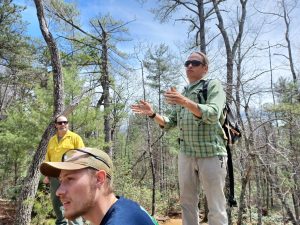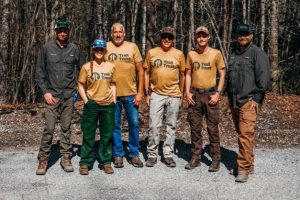At the recent Great Trails Workshop in North Carolina funded by Trail Trust, we not only had the fortune of meeting Shawn Lindsey we also got to know Matt Fusco.

Matt is a landscape architect based in Western North Carolina who moved to the area in 1999 to pursue his passion for the mountains and bikes. He worked for Melrose Design Group from 1999 – 2009 where he was exposed to large-scale land development and the challenges associated with development in the area.
Matt describes what happened next, “After the close of Melrose Design Group in late 2009, I maintained key projects I worked on while with the firm and worked full-time for the U.S. Forest Service as the Landscape Architect for the Cherokee National Forest. In my work for the Cherokee National Forest, I was responsible for evaluating forest management strategies as it relates to scenery and impacts on the greater landscape as well as design and development of recreation opportunities, including trailheads, camping areas, and trail system planning.”
Currently, Matt runs Fusco Land Planning and Design about which he says, “Whether your project is a plaza and fountain design, an overall camp master plan and trail system, or site planning for your dream home, we have the experience to effectively design, plan and fully manage your project.”
While Matt’s favorite form of recreation is mountain biking, he has some experience with OHVs, “Most of my OHV experience comes from my time with the Cherokee National Forest where I spent a lot of hours working on the Buffalo Mountain ATV trail,” that features 13 miles of trails.
“I want everyone to enjoy the outdoors, so if your choice is to be on an OHV, I support that.” Matt’s philosophy of inclusion extends to all appropriate uses of outdoor spaces, “I am a bike person, but it can only be of benefit for me to better understand how to best manage OHV use. It would be nice if everyone understood the different impacts that different uses have, and if everyone understood that we share the common goal of responsibly enjoying the outdoors. I am not an advocate of separating uses entirely. I believe in appropriately intermingling uses which leads to bringing groups together and we can all work together to create and manage great trail systems.”

NOHVCC’s Tennessee State Partner Mike Farmer who introduced Matt to NOHVCC has seen Matt incorporate his philosophy first-hand, “I have known Matt for years and have always appreciated his fairness and willingness to work with all forms of recreation.”
It was his openness to all forms of recreation that led Matt to participate in the North Carolina Great Trails Workshop. “The Great Trails Workshop was a great experience with very knowledgeable instructors. It was great to see that for the most part the Workshop promoted similar concepts that apply for trails of all different uses, while highlighting issues unique to OHV trails. The differences came to the forefront when discussing grade reversals. While the concepts apply to any type of trail, OHVs need longer breaks because they use a motor, we don’t have to think about that as much on bike trails. The unique elements were well articulated and highlighted – it was a good approach and thoughtful in how it was presented.”
Matt’s experience came to light while at the Workshop when he noticed water collecting on the outer berm of a trail, he used his boot heel to carve an opening in the berm that would allow the water to drain. NOHVCC’s Marc Hildesheim commented, “Matt knows why we stopped here – we have to take action to keep water from pooling on the trail.”
About managing water Matt said, “Addressing water management is the most critical component to long term sustainability of trails and is the basis from which we do most of our planning and layout. Water is one of the primary things we focus on in all design.”
Matt also believes it is better, when possible, to properly design trail systems from the start rather than use whatever existing routes might be available. “Clearly sometimes we must use what is already on the ground, but one of biggest pigeonholes we get stuck in is to just use whatever is already there – like converting a road to a trail. Often you can spend as much time as you would from starting over. If we use existing trails, everything we do is always going to be a band aid if you try to hold an alignment that is incorrect from the beginning. Sometimes ongoing maintenance costs could be 50% less on trails that are properly laid out and built.”
When asked, what is the most important thing an individual can do to ensure a positive future for OHV recreation, Matt responded, “Tread lightly and understand the impacts of the use you choose to do and act as if trails were your own. Urge your peers to get involved – we all have a responsibility to protect the trails, if everyone took a more civil approach to other user groups it would help us maintain longevity for all uses.”
Finally, Matt echoed NOHVCC’s sentiments when he said, “At the end of the day we are all just trying to recreate and there is only one way to be successful. Reach out to managers and other users and have a dialogue. Every group could do better and more collaboration at the front end might keep areas open longer.”
To read more about the North Carolina Workshop funded by Trail Trust click here, here, and here.
For more information about grant opportunities through Trail Trust click here.